Bunnings Online Shop: Warehouse Distribution & Layout Strategy Report
VerifiedAdded on 2023/06/14
|8
|2800
|289
Report
AI Summary
This report details a warehouse and distribution strategy for Bunnings' online shop, considering Brisbane's demographic and online shopping trends. The proposed warehouse design prioritizes efficient delivery, categorizing goods by weight, sales turnover, space requirements, and retrieval methods. The 20,000 square foot facility, with a height of 56 feet, is divided into two levels: the ground floor for heavy and bulky items and the second level for offices and lighter, faster-moving goods. The allocation criteria are based on weight and size, with bulky items placed in designated sections for faster retrieval. The report emphasizes the FAST concept (Flow, Accessibility, Space, Throughput) to optimize warehouse operations, ensuring efficient product flow, accessibility of items, optimized space utilization through shelving and stacking, and high throughput. Batch picking is recommended for order fulfillment, with dedicated pickers in each zone to minimize travel time and distance. This strategy ensures efficient warehouse operations, minimizing delays and maximizing throughput for Bunnings' online shop.

WAREHOUSE AND DISTRIBUTION
WAREHOUSE AND DISTRIBUTION
NAME OF STUDENT
NAME OF UNIVERSITY
WAREHOUSE AND DISTRIBUTION
NAME OF STUDENT
NAME OF UNIVERSITY
Paraphrase This Document
Need a fresh take? Get an instant paraphrase of this document with our AI Paraphraser
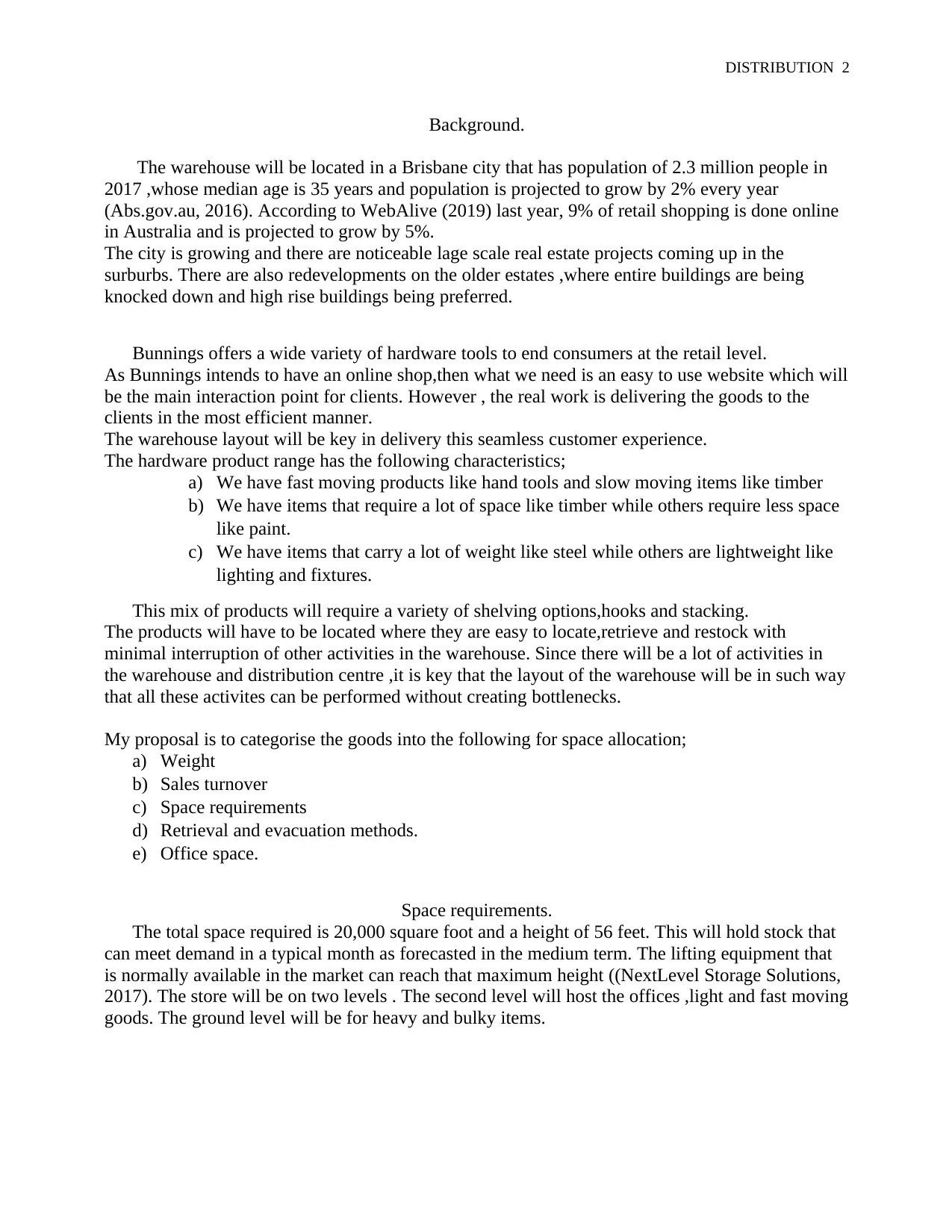
DISTRIBUTION 2
Background.
The warehouse will be located in a Brisbane city that has population of 2.3 million people in
2017 ,whose median age is 35 years and population is projected to grow by 2% every year
(Abs.gov.au, 2016). According to WebAlive (2019) last year, 9% of retail shopping is done online
in Australia and is projected to grow by 5%.
The city is growing and there are noticeable lage scale real estate projects coming up in the
surburbs. There are also redevelopments on the older estates ,where entire buildings are being
knocked down and high rise buildings being preferred.
Bunnings offers a wide variety of hardware tools to end consumers at the retail level.
As Bunnings intends to have an online shop,then what we need is an easy to use website which will
be the main interaction point for clients. However , the real work is delivering the goods to the
clients in the most efficient manner.
The warehouse layout will be key in delivery this seamless customer experience.
The hardware product range has the following characteristics;
a) We have fast moving products like hand tools and slow moving items like timber
b) We have items that require a lot of space like timber while others require less space
like paint.
c) We have items that carry a lot of weight like steel while others are lightweight like
lighting and fixtures.
This mix of products will require a variety of shelving options,hooks and stacking.
The products will have to be located where they are easy to locate,retrieve and restock with
minimal interruption of other activities in the warehouse. Since there will be a lot of activities in
the warehouse and distribution centre ,it is key that the layout of the warehouse will be in such way
that all these activites can be performed without creating bottlenecks.
My proposal is to categorise the goods into the following for space allocation;
a) Weight
b) Sales turnover
c) Space requirements
d) Retrieval and evacuation methods.
e) Office space.
Space requirements.
The total space required is 20,000 square foot and a height of 56 feet. This will hold stock that
can meet demand in a typical month as forecasted in the medium term. The lifting equipment that
is normally available in the market can reach that maximum height ((NextLevel Storage Solutions,
2017). The store will be on two levels . The second level will host the offices ,light and fast moving
goods. The ground level will be for heavy and bulky items.
Background.
The warehouse will be located in a Brisbane city that has population of 2.3 million people in
2017 ,whose median age is 35 years and population is projected to grow by 2% every year
(Abs.gov.au, 2016). According to WebAlive (2019) last year, 9% of retail shopping is done online
in Australia and is projected to grow by 5%.
The city is growing and there are noticeable lage scale real estate projects coming up in the
surburbs. There are also redevelopments on the older estates ,where entire buildings are being
knocked down and high rise buildings being preferred.
Bunnings offers a wide variety of hardware tools to end consumers at the retail level.
As Bunnings intends to have an online shop,then what we need is an easy to use website which will
be the main interaction point for clients. However , the real work is delivering the goods to the
clients in the most efficient manner.
The warehouse layout will be key in delivery this seamless customer experience.
The hardware product range has the following characteristics;
a) We have fast moving products like hand tools and slow moving items like timber
b) We have items that require a lot of space like timber while others require less space
like paint.
c) We have items that carry a lot of weight like steel while others are lightweight like
lighting and fixtures.
This mix of products will require a variety of shelving options,hooks and stacking.
The products will have to be located where they are easy to locate,retrieve and restock with
minimal interruption of other activities in the warehouse. Since there will be a lot of activities in
the warehouse and distribution centre ,it is key that the layout of the warehouse will be in such way
that all these activites can be performed without creating bottlenecks.
My proposal is to categorise the goods into the following for space allocation;
a) Weight
b) Sales turnover
c) Space requirements
d) Retrieval and evacuation methods.
e) Office space.
Space requirements.
The total space required is 20,000 square foot and a height of 56 feet. This will hold stock that
can meet demand in a typical month as forecasted in the medium term. The lifting equipment that
is normally available in the market can reach that maximum height ((NextLevel Storage Solutions,
2017). The store will be on two levels . The second level will host the offices ,light and fast moving
goods. The ground level will be for heavy and bulky items.
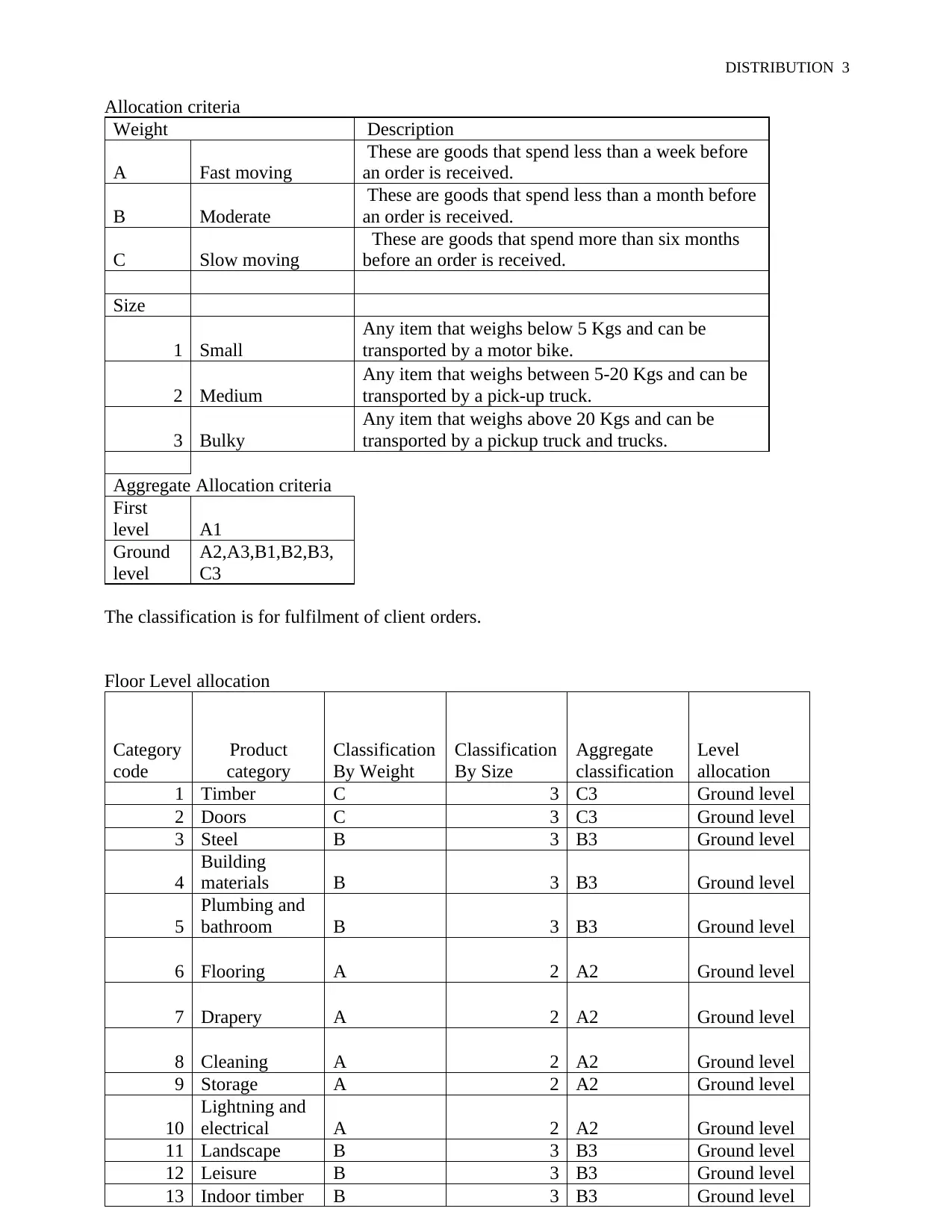
DISTRIBUTION 3
Allocation criteria
Weight Description
A Fast moving
These are goods that spend less than a week before
an order is received.
B Moderate
These are goods that spend less than a month before
an order is received.
C Slow moving
These are goods that spend more than six months
before an order is received.
Size
1 Small
Any item that weighs below 5 Kgs and can be
transported by a motor bike.
2 Medium
Any item that weighs between 5-20 Kgs and can be
transported by a pick-up truck.
3 Bulky
Any item that weighs above 20 Kgs and can be
transported by a pickup truck and trucks.
Aggregate Allocation criteria
First
level A1
Ground
level
A2,A3,B1,B2,B3,
C3
The classification is for fulfilment of client orders.
Floor Level allocation
Category
code
Product
category
Classification
By Weight
Classification
By Size
Aggregate
classification
Level
allocation
1 Timber C 3 C3 Ground level
2 Doors C 3 C3 Ground level
3 Steel B 3 B3 Ground level
4
Building
materials B 3 B3 Ground level
5
Plumbing and
bathroom B 3 B3 Ground level
6 Flooring A 2 A2 Ground level
7 Drapery A 2 A2 Ground level
8 Cleaning A 2 A2 Ground level
9 Storage A 2 A2 Ground level
10
Lightning and
electrical A 2 A2 Ground level
11 Landscape B 3 B3 Ground level
12 Leisure B 3 B3 Ground level
13 Indoor timber B 3 B3 Ground level
Allocation criteria
Weight Description
A Fast moving
These are goods that spend less than a week before
an order is received.
B Moderate
These are goods that spend less than a month before
an order is received.
C Slow moving
These are goods that spend more than six months
before an order is received.
Size
1 Small
Any item that weighs below 5 Kgs and can be
transported by a motor bike.
2 Medium
Any item that weighs between 5-20 Kgs and can be
transported by a pick-up truck.
3 Bulky
Any item that weighs above 20 Kgs and can be
transported by a pickup truck and trucks.
Aggregate Allocation criteria
First
level A1
Ground
level
A2,A3,B1,B2,B3,
C3
The classification is for fulfilment of client orders.
Floor Level allocation
Category
code
Product
category
Classification
By Weight
Classification
By Size
Aggregate
classification
Level
allocation
1 Timber C 3 C3 Ground level
2 Doors C 3 C3 Ground level
3 Steel B 3 B3 Ground level
4
Building
materials B 3 B3 Ground level
5
Plumbing and
bathroom B 3 B3 Ground level
6 Flooring A 2 A2 Ground level
7 Drapery A 2 A2 Ground level
8 Cleaning A 2 A2 Ground level
9 Storage A 2 A2 Ground level
10
Lightning and
electrical A 2 A2 Ground level
11 Landscape B 3 B3 Ground level
12 Leisure B 3 B3 Ground level
13 Indoor timber B 3 B3 Ground level
⊘ This is a preview!⊘
Do you want full access?
Subscribe today to unlock all pages.

Trusted by 1+ million students worldwide
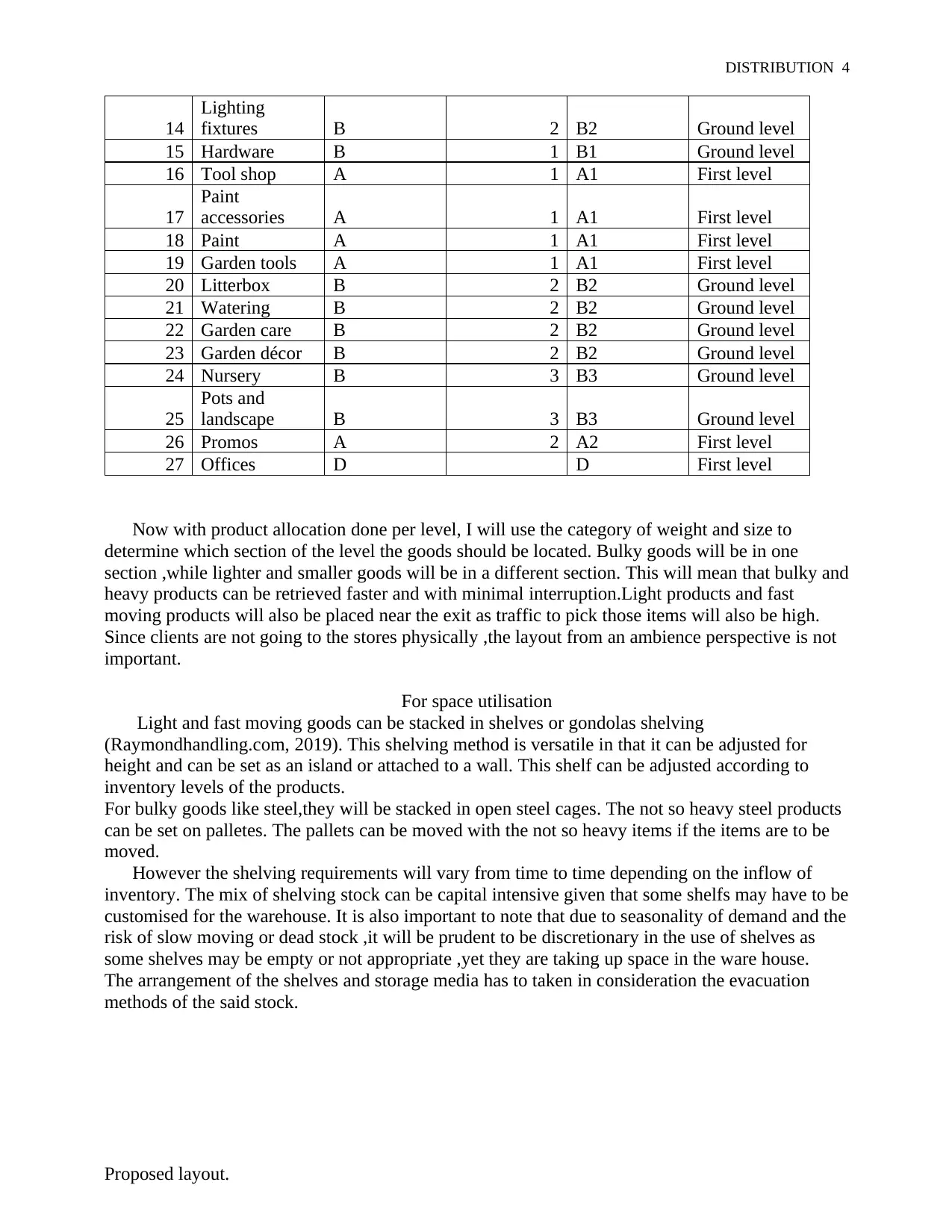
DISTRIBUTION 4
14
Lighting
fixtures B 2 B2 Ground level
15 Hardware B 1 B1 Ground level
16 Tool shop A 1 A1 First level
17
Paint
accessories A 1 A1 First level
18 Paint A 1 A1 First level
19 Garden tools A 1 A1 First level
20 Litterbox B 2 B2 Ground level
21 Watering B 2 B2 Ground level
22 Garden care B 2 B2 Ground level
23 Garden décor B 2 B2 Ground level
24 Nursery B 3 B3 Ground level
25
Pots and
landscape B 3 B3 Ground level
26 Promos A 2 A2 First level
27 Offices D D First level
Now with product allocation done per level, I will use the category of weight and size to
determine which section of the level the goods should be located. Bulky goods will be in one
section ,while lighter and smaller goods will be in a different section. This will mean that bulky and
heavy products can be retrieved faster and with minimal interruption.Light products and fast
moving products will also be placed near the exit as traffic to pick those items will also be high.
Since clients are not going to the stores physically ,the layout from an ambience perspective is not
important.
For space utilisation
Light and fast moving goods can be stacked in shelves or gondolas shelving
(Raymondhandling.com, 2019). This shelving method is versatile in that it can be adjusted for
height and can be set as an island or attached to a wall. This shelf can be adjusted according to
inventory levels of the products.
For bulky goods like steel,they will be stacked in open steel cages. The not so heavy steel products
can be set on palletes. The pallets can be moved with the not so heavy items if the items are to be
moved.
However the shelving requirements will vary from time to time depending on the inflow of
inventory. The mix of shelving stock can be capital intensive given that some shelfs may have to be
customised for the warehouse. It is also important to note that due to seasonality of demand and the
risk of slow moving or dead stock ,it will be prudent to be discretionary in the use of shelves as
some shelves may be empty or not appropriate ,yet they are taking up space in the ware house.
The arrangement of the shelves and storage media has to taken in consideration the evacuation
methods of the said stock.
Proposed layout.
14
Lighting
fixtures B 2 B2 Ground level
15 Hardware B 1 B1 Ground level
16 Tool shop A 1 A1 First level
17
Paint
accessories A 1 A1 First level
18 Paint A 1 A1 First level
19 Garden tools A 1 A1 First level
20 Litterbox B 2 B2 Ground level
21 Watering B 2 B2 Ground level
22 Garden care B 2 B2 Ground level
23 Garden décor B 2 B2 Ground level
24 Nursery B 3 B3 Ground level
25
Pots and
landscape B 3 B3 Ground level
26 Promos A 2 A2 First level
27 Offices D D First level
Now with product allocation done per level, I will use the category of weight and size to
determine which section of the level the goods should be located. Bulky goods will be in one
section ,while lighter and smaller goods will be in a different section. This will mean that bulky and
heavy products can be retrieved faster and with minimal interruption.Light products and fast
moving products will also be placed near the exit as traffic to pick those items will also be high.
Since clients are not going to the stores physically ,the layout from an ambience perspective is not
important.
For space utilisation
Light and fast moving goods can be stacked in shelves or gondolas shelving
(Raymondhandling.com, 2019). This shelving method is versatile in that it can be adjusted for
height and can be set as an island or attached to a wall. This shelf can be adjusted according to
inventory levels of the products.
For bulky goods like steel,they will be stacked in open steel cages. The not so heavy steel products
can be set on palletes. The pallets can be moved with the not so heavy items if the items are to be
moved.
However the shelving requirements will vary from time to time depending on the inflow of
inventory. The mix of shelving stock can be capital intensive given that some shelfs may have to be
customised for the warehouse. It is also important to note that due to seasonality of demand and the
risk of slow moving or dead stock ,it will be prudent to be discretionary in the use of shelves as
some shelves may be empty or not appropriate ,yet they are taking up space in the ware house.
The arrangement of the shelves and storage media has to taken in consideration the evacuation
methods of the said stock.
Proposed layout.
Paraphrase This Document
Need a fresh take? Get an instant paraphrase of this document with our AI Paraphraser
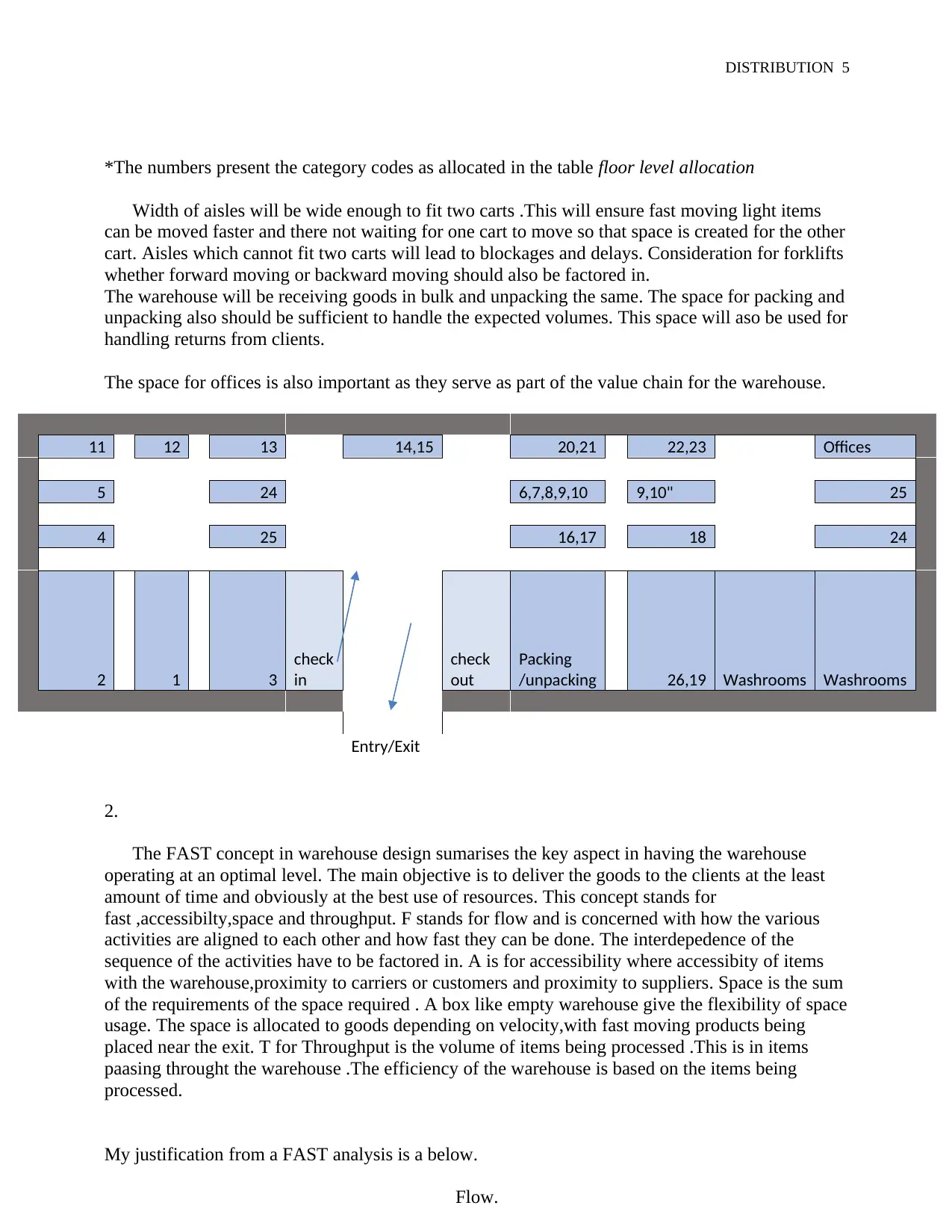
DISTRIBUTION 5
*The numbers present the category codes as allocated in the table floor level allocation
Width of aisles will be wide enough to fit two carts .This will ensure fast moving light items
can be moved faster and there not waiting for one cart to move so that space is created for the other
cart. Aisles which cannot fit two carts will lead to blockages and delays. Consideration for forklifts
whether forward moving or backward moving should also be factored in.
The warehouse will be receiving goods in bulk and unpacking the same. The space for packing and
unpacking also should be sufficient to handle the expected volumes. This space will aso be used for
handling returns from clients.
The space for offices is also important as they serve as part of the value chain for the warehouse.
11 12 13 14,15 20,21 22,23 Offices
5 24 6,7,8,9,10 9,10" 25
4 25 16,17 18 24
2 1 3
check
in
check
out
Packing
/unpacking 26,19 Washrooms Washrooms
Entry/Exit
2.
The FAST concept in warehouse design sumarises the key aspect in having the warehouse
operating at an optimal level. The main objective is to deliver the goods to the clients at the least
amount of time and obviously at the best use of resources. This concept stands for
fast ,accessibilty,space and throughput. F stands for flow and is concerned with how the various
activities are aligned to each other and how fast they can be done. The interdepedence of the
sequence of the activities have to be factored in. A is for accessibility where accessibity of items
with the warehouse,proximity to carriers or customers and proximity to suppliers. Space is the sum
of the requirements of the space required . A box like empty warehouse give the flexibility of space
usage. The space is allocated to goods depending on velocity,with fast moving products being
placed near the exit. T for Throughput is the volume of items being processed .This is in items
paasing throught the warehouse .The efficiency of the warehouse is based on the items being
processed.
My justification from a FAST analysis is a below.
Flow.
*The numbers present the category codes as allocated in the table floor level allocation
Width of aisles will be wide enough to fit two carts .This will ensure fast moving light items
can be moved faster and there not waiting for one cart to move so that space is created for the other
cart. Aisles which cannot fit two carts will lead to blockages and delays. Consideration for forklifts
whether forward moving or backward moving should also be factored in.
The warehouse will be receiving goods in bulk and unpacking the same. The space for packing and
unpacking also should be sufficient to handle the expected volumes. This space will aso be used for
handling returns from clients.
The space for offices is also important as they serve as part of the value chain for the warehouse.
11 12 13 14,15 20,21 22,23 Offices
5 24 6,7,8,9,10 9,10" 25
4 25 16,17 18 24
2 1 3
check
in
check
out
Packing
/unpacking 26,19 Washrooms Washrooms
Entry/Exit
2.
The FAST concept in warehouse design sumarises the key aspect in having the warehouse
operating at an optimal level. The main objective is to deliver the goods to the clients at the least
amount of time and obviously at the best use of resources. This concept stands for
fast ,accessibilty,space and throughput. F stands for flow and is concerned with how the various
activities are aligned to each other and how fast they can be done. The interdepedence of the
sequence of the activities have to be factored in. A is for accessibility where accessibity of items
with the warehouse,proximity to carriers or customers and proximity to suppliers. Space is the sum
of the requirements of the space required . A box like empty warehouse give the flexibility of space
usage. The space is allocated to goods depending on velocity,with fast moving products being
placed near the exit. T for Throughput is the volume of items being processed .This is in items
paasing throught the warehouse .The efficiency of the warehouse is based on the items being
processed.
My justification from a FAST analysis is a below.
Flow.
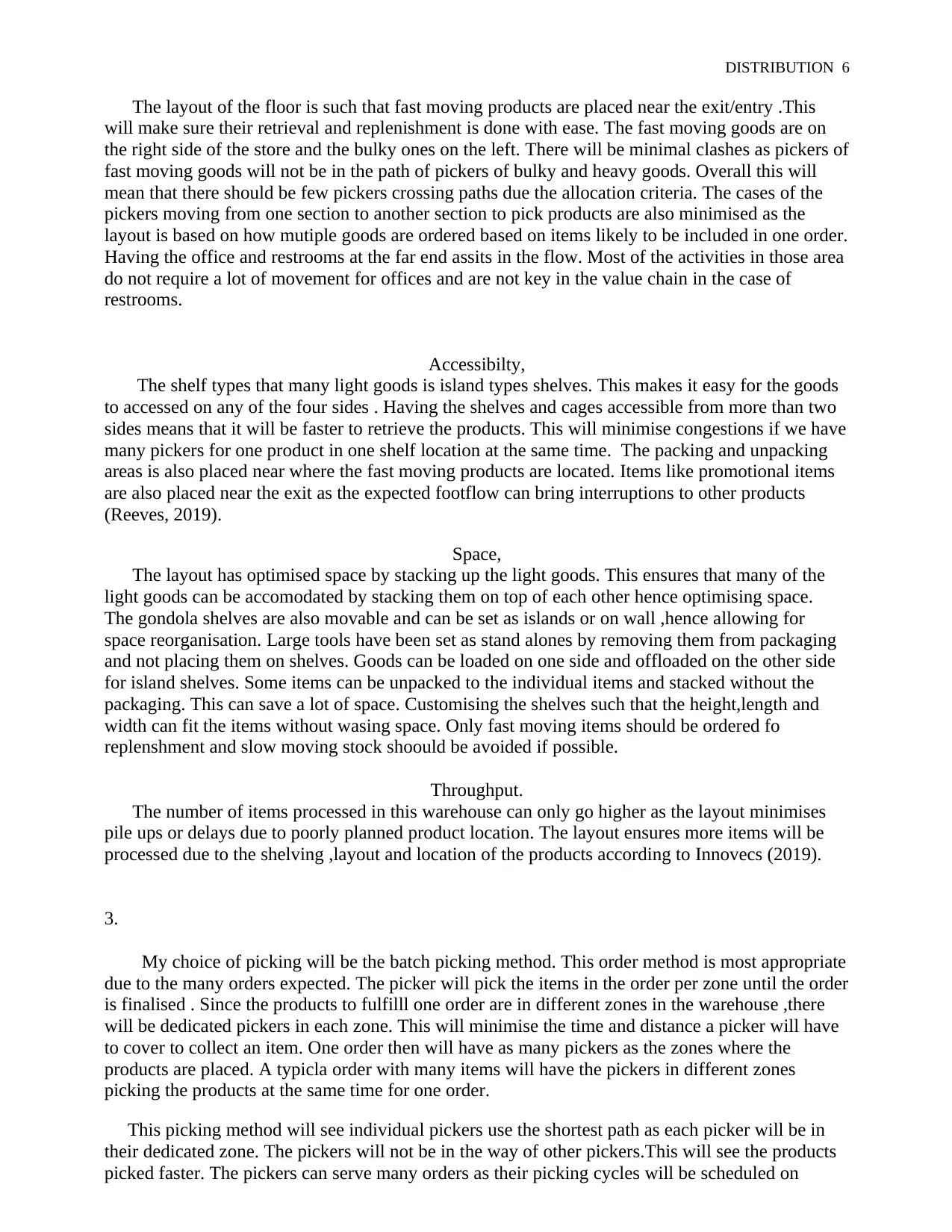
DISTRIBUTION 6
The layout of the floor is such that fast moving products are placed near the exit/entry .This
will make sure their retrieval and replenishment is done with ease. The fast moving goods are on
the right side of the store and the bulky ones on the left. There will be minimal clashes as pickers of
fast moving goods will not be in the path of pickers of bulky and heavy goods. Overall this will
mean that there should be few pickers crossing paths due the allocation criteria. The cases of the
pickers moving from one section to another section to pick products are also minimised as the
layout is based on how mutiple goods are ordered based on items likely to be included in one order.
Having the office and restrooms at the far end assits in the flow. Most of the activities in those area
do not require a lot of movement for offices and are not key in the value chain in the case of
restrooms.
Accessibilty,
The shelf types that many light goods is island types shelves. This makes it easy for the goods
to accessed on any of the four sides . Having the shelves and cages accessible from more than two
sides means that it will be faster to retrieve the products. This will minimise congestions if we have
many pickers for one product in one shelf location at the same time. The packing and unpacking
areas is also placed near where the fast moving products are located. Items like promotional items
are also placed near the exit as the expected footflow can bring interruptions to other products
(Reeves, 2019).
Space,
The layout has optimised space by stacking up the light goods. This ensures that many of the
light goods can be accomodated by stacking them on top of each other hence optimising space.
The gondola shelves are also movable and can be set as islands or on wall ,hence allowing for
space reorganisation. Large tools have been set as stand alones by removing them from packaging
and not placing them on shelves. Goods can be loaded on one side and offloaded on the other side
for island shelves. Some items can be unpacked to the individual items and stacked without the
packaging. This can save a lot of space. Customising the shelves such that the height,length and
width can fit the items without wasing space. Only fast moving items should be ordered fo
replenshment and slow moving stock shoould be avoided if possible.
Throughput.
The number of items processed in this warehouse can only go higher as the layout minimises
pile ups or delays due to poorly planned product location. The layout ensures more items will be
processed due to the shelving ,layout and location of the products according to Innovecs (2019).
3.
My choice of picking will be the batch picking method. This order method is most appropriate
due to the many orders expected. The picker will pick the items in the order per zone until the order
is finalised . Since the products to fulfilll one order are in different zones in the warehouse ,there
will be dedicated pickers in each zone. This will minimise the time and distance a picker will have
to cover to collect an item. One order then will have as many pickers as the zones where the
products are placed. A typicla order with many items will have the pickers in different zones
picking the products at the same time for one order.
This picking method will see individual pickers use the shortest path as each picker will be in
their dedicated zone. The pickers will not be in the way of other pickers.This will see the products
picked faster. The pickers can serve many orders as their picking cycles will be scheduled on
The layout of the floor is such that fast moving products are placed near the exit/entry .This
will make sure their retrieval and replenishment is done with ease. The fast moving goods are on
the right side of the store and the bulky ones on the left. There will be minimal clashes as pickers of
fast moving goods will not be in the path of pickers of bulky and heavy goods. Overall this will
mean that there should be few pickers crossing paths due the allocation criteria. The cases of the
pickers moving from one section to another section to pick products are also minimised as the
layout is based on how mutiple goods are ordered based on items likely to be included in one order.
Having the office and restrooms at the far end assits in the flow. Most of the activities in those area
do not require a lot of movement for offices and are not key in the value chain in the case of
restrooms.
Accessibilty,
The shelf types that many light goods is island types shelves. This makes it easy for the goods
to accessed on any of the four sides . Having the shelves and cages accessible from more than two
sides means that it will be faster to retrieve the products. This will minimise congestions if we have
many pickers for one product in one shelf location at the same time. The packing and unpacking
areas is also placed near where the fast moving products are located. Items like promotional items
are also placed near the exit as the expected footflow can bring interruptions to other products
(Reeves, 2019).
Space,
The layout has optimised space by stacking up the light goods. This ensures that many of the
light goods can be accomodated by stacking them on top of each other hence optimising space.
The gondola shelves are also movable and can be set as islands or on wall ,hence allowing for
space reorganisation. Large tools have been set as stand alones by removing them from packaging
and not placing them on shelves. Goods can be loaded on one side and offloaded on the other side
for island shelves. Some items can be unpacked to the individual items and stacked without the
packaging. This can save a lot of space. Customising the shelves such that the height,length and
width can fit the items without wasing space. Only fast moving items should be ordered fo
replenshment and slow moving stock shoould be avoided if possible.
Throughput.
The number of items processed in this warehouse can only go higher as the layout minimises
pile ups or delays due to poorly planned product location. The layout ensures more items will be
processed due to the shelving ,layout and location of the products according to Innovecs (2019).
3.
My choice of picking will be the batch picking method. This order method is most appropriate
due to the many orders expected. The picker will pick the items in the order per zone until the order
is finalised . Since the products to fulfilll one order are in different zones in the warehouse ,there
will be dedicated pickers in each zone. This will minimise the time and distance a picker will have
to cover to collect an item. One order then will have as many pickers as the zones where the
products are placed. A typicla order with many items will have the pickers in different zones
picking the products at the same time for one order.
This picking method will see individual pickers use the shortest path as each picker will be in
their dedicated zone. The pickers will not be in the way of other pickers.This will see the products
picked faster. The pickers can serve many orders as their picking cycles will be scheduled on
⊘ This is a preview!⊘
Do you want full access?
Subscribe today to unlock all pages.

Trusted by 1+ million students worldwide

DISTRIBUTION 7
regular intervals or when the threshold of items to be retrieved in one zone is reached. This
capability of serving many orders is key to achieving maximum productivity of the pickers.
This batch picking is appropriate for the small items and where items in an order are also few.
Since the warehouse also has bulky items we can complement this by having another appropriate
picking method. Discrete order picking can be used for orders with single items which are bulky
and heavy. This method is flexible as it does not have to be scheduled. It is also high in accuracy as
the picker is only piking one item.This order method fulfils orders more quickly that any other
method.
regular intervals or when the threshold of items to be retrieved in one zone is reached. This
capability of serving many orders is key to achieving maximum productivity of the pickers.
This batch picking is appropriate for the small items and where items in an order are also few.
Since the warehouse also has bulky items we can complement this by having another appropriate
picking method. Discrete order picking can be used for orders with single items which are bulky
and heavy. This method is flexible as it does not have to be scheduled. It is also high in accuracy as
the picker is only piking one item.This order method fulfils orders more quickly that any other
method.
Paraphrase This Document
Need a fresh take? Get an instant paraphrase of this document with our AI Paraphraser
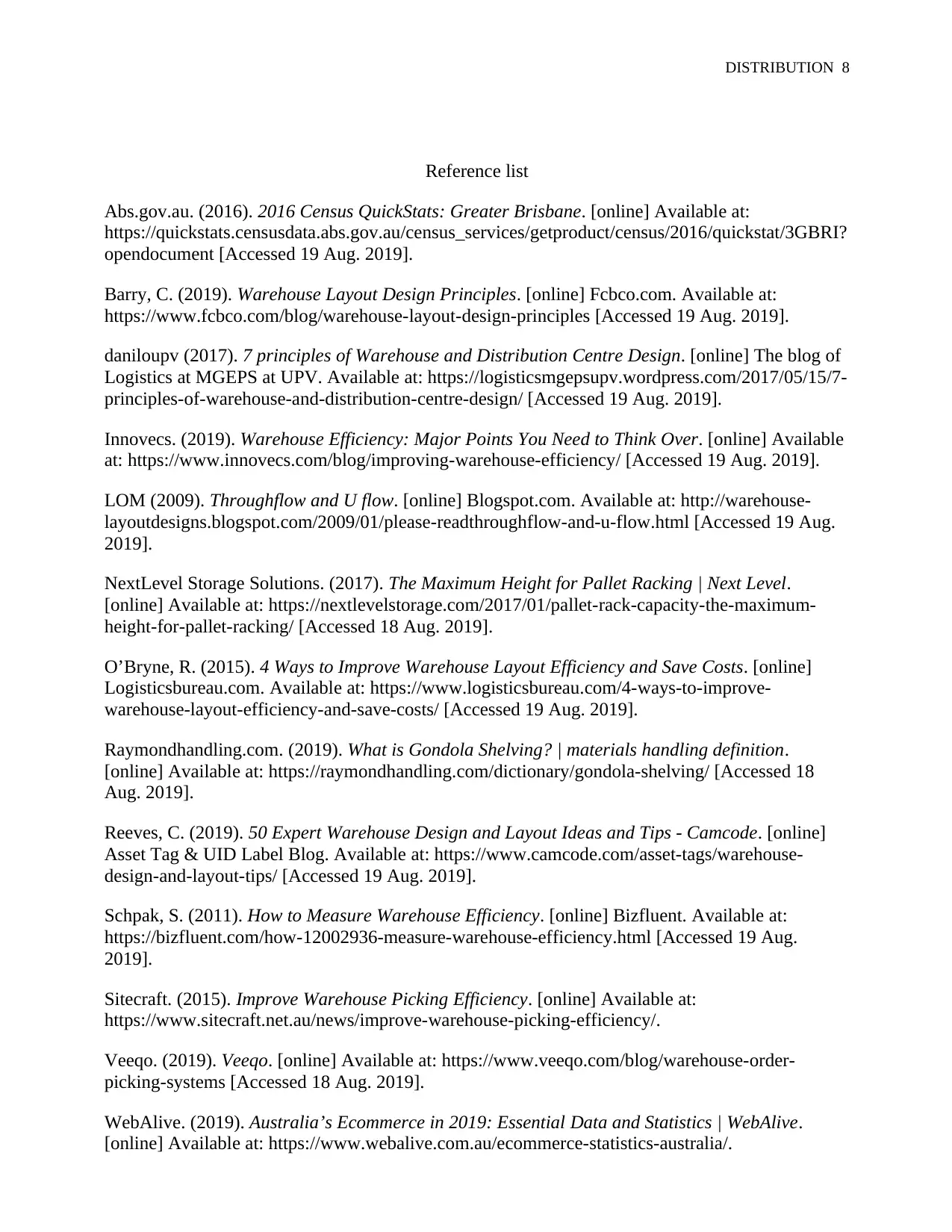
DISTRIBUTION 8
Reference list
Abs.gov.au. (2016). 2016 Census QuickStats: Greater Brisbane. [online] Available at:
https://quickstats.censusdata.abs.gov.au/census_services/getproduct/census/2016/quickstat/3GBRI?
opendocument [Accessed 19 Aug. 2019].
Barry, C. (2019). Warehouse Layout Design Principles. [online] Fcbco.com. Available at:
https://www.fcbco.com/blog/warehouse-layout-design-principles [Accessed 19 Aug. 2019].
daniloupv (2017). 7 principles of Warehouse and Distribution Centre Design. [online] The blog of
Logistics at MGEPS at UPV. Available at: https://logisticsmgepsupv.wordpress.com/2017/05/15/7-
principles-of-warehouse-and-distribution-centre-design/ [Accessed 19 Aug. 2019].
Innovecs. (2019). Warehouse Efficiency: Major Points You Need to Think Over. [online] Available
at: https://www.innovecs.com/blog/improving-warehouse-efficiency/ [Accessed 19 Aug. 2019].
LOM (2009). Throughflow and U flow. [online] Blogspot.com. Available at: http://warehouse-
layoutdesigns.blogspot.com/2009/01/please-readthroughflow-and-u-flow.html [Accessed 19 Aug.
2019].
NextLevel Storage Solutions. (2017). The Maximum Height for Pallet Racking | Next Level.
[online] Available at: https://nextlevelstorage.com/2017/01/pallet-rack-capacity-the-maximum-
height-for-pallet-racking/ [Accessed 18 Aug. 2019].
O’Bryne, R. (2015). 4 Ways to Improve Warehouse Layout Efficiency and Save Costs. [online]
Logisticsbureau.com. Available at: https://www.logisticsbureau.com/4-ways-to-improve-
warehouse-layout-efficiency-and-save-costs/ [Accessed 19 Aug. 2019].
Raymondhandling.com. (2019). What is Gondola Shelving? | materials handling definition.
[online] Available at: https://raymondhandling.com/dictionary/gondola-shelving/ [Accessed 18
Aug. 2019].
Reeves, C. (2019). 50 Expert Warehouse Design and Layout Ideas and Tips - Camcode. [online]
Asset Tag & UID Label Blog. Available at: https://www.camcode.com/asset-tags/warehouse-
design-and-layout-tips/ [Accessed 19 Aug. 2019].
Schpak, S. (2011). How to Measure Warehouse Efficiency. [online] Bizfluent. Available at:
https://bizfluent.com/how-12002936-measure-warehouse-efficiency.html [Accessed 19 Aug.
2019].
Sitecraft. (2015). Improve Warehouse Picking Efficiency. [online] Available at:
https://www.sitecraft.net.au/news/improve-warehouse-picking-efficiency/.
Veeqo. (2019). Veeqo. [online] Available at: https://www.veeqo.com/blog/warehouse-order-
picking-systems [Accessed 18 Aug. 2019].
WebAlive. (2019). Australia’s Ecommerce in 2019: Essential Data and Statistics | WebAlive.
[online] Available at: https://www.webalive.com.au/ecommerce-statistics-australia/.
Reference list
Abs.gov.au. (2016). 2016 Census QuickStats: Greater Brisbane. [online] Available at:
https://quickstats.censusdata.abs.gov.au/census_services/getproduct/census/2016/quickstat/3GBRI?
opendocument [Accessed 19 Aug. 2019].
Barry, C. (2019). Warehouse Layout Design Principles. [online] Fcbco.com. Available at:
https://www.fcbco.com/blog/warehouse-layout-design-principles [Accessed 19 Aug. 2019].
daniloupv (2017). 7 principles of Warehouse and Distribution Centre Design. [online] The blog of
Logistics at MGEPS at UPV. Available at: https://logisticsmgepsupv.wordpress.com/2017/05/15/7-
principles-of-warehouse-and-distribution-centre-design/ [Accessed 19 Aug. 2019].
Innovecs. (2019). Warehouse Efficiency: Major Points You Need to Think Over. [online] Available
at: https://www.innovecs.com/blog/improving-warehouse-efficiency/ [Accessed 19 Aug. 2019].
LOM (2009). Throughflow and U flow. [online] Blogspot.com. Available at: http://warehouse-
layoutdesigns.blogspot.com/2009/01/please-readthroughflow-and-u-flow.html [Accessed 19 Aug.
2019].
NextLevel Storage Solutions. (2017). The Maximum Height for Pallet Racking | Next Level.
[online] Available at: https://nextlevelstorage.com/2017/01/pallet-rack-capacity-the-maximum-
height-for-pallet-racking/ [Accessed 18 Aug. 2019].
O’Bryne, R. (2015). 4 Ways to Improve Warehouse Layout Efficiency and Save Costs. [online]
Logisticsbureau.com. Available at: https://www.logisticsbureau.com/4-ways-to-improve-
warehouse-layout-efficiency-and-save-costs/ [Accessed 19 Aug. 2019].
Raymondhandling.com. (2019). What is Gondola Shelving? | materials handling definition.
[online] Available at: https://raymondhandling.com/dictionary/gondola-shelving/ [Accessed 18
Aug. 2019].
Reeves, C. (2019). 50 Expert Warehouse Design and Layout Ideas and Tips - Camcode. [online]
Asset Tag & UID Label Blog. Available at: https://www.camcode.com/asset-tags/warehouse-
design-and-layout-tips/ [Accessed 19 Aug. 2019].
Schpak, S. (2011). How to Measure Warehouse Efficiency. [online] Bizfluent. Available at:
https://bizfluent.com/how-12002936-measure-warehouse-efficiency.html [Accessed 19 Aug.
2019].
Sitecraft. (2015). Improve Warehouse Picking Efficiency. [online] Available at:
https://www.sitecraft.net.au/news/improve-warehouse-picking-efficiency/.
Veeqo. (2019). Veeqo. [online] Available at: https://www.veeqo.com/blog/warehouse-order-
picking-systems [Accessed 18 Aug. 2019].
WebAlive. (2019). Australia’s Ecommerce in 2019: Essential Data and Statistics | WebAlive.
[online] Available at: https://www.webalive.com.au/ecommerce-statistics-australia/.
1 out of 8
Your All-in-One AI-Powered Toolkit for Academic Success.
+13062052269
info@desklib.com
Available 24*7 on WhatsApp / Email
![[object Object]](/_next/static/media/star-bottom.7253800d.svg)
Unlock your academic potential
Copyright © 2020–2025 A2Z Services. All Rights Reserved. Developed and managed by ZUCOL.